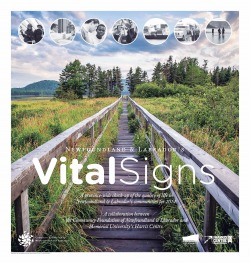New report captures "Vital Signs" of the province

If Newfoundland and Labrador was made up of 100 people, there would be 49 males and 51 females, their average age would be 44 years, their life expectancy – 78.9 years, and 40 of them would live on the Northeast Avalon, 5 would live in Labrador. There would be 57 people between the ages of 25 and 64, and 15 people younger than 15 years old.
This information and more can be found in the province’s first ever Vital Signs, an annual report on key quality of life indicators in Newfoundland and Labrador. The report was released on October 7, 2014 by the Community Foundation of Newfoundland and Labrador (CFNL) in partnership with Memorial University’s Leslie Harris Centre of Regional Policy and Development at a launch event with community stakeholders and expert contributors. As part of a unique partnership with TC Media, the full report is also printed as an insert in every copy of The Telegram and will appear in each of TC Media’s regional papers across the province.
Part of Community Foundations of Canada’s national Vital Signs program, the report provides a comprehensive, reader-friendly look at how Newfoundland and Labrador communities are faring in key issue areas.
“We are so pleased to be presenting this province’s first Vital Signs report,” said Jennifer Guy, chair of CFNL. “This report marks the beginning of an ongoing discussion about the health of our province. We want to bring community organizations and leaders into the discussion and use this report as a way to work together to build stronger communities.”
The report looks at 13 different quality of life indicators across 12 different regions in the province: the gap between rich and poor, safety, health, learning, housing, youth, newcomers, arts & culture, environment, population, economy, belonging & leadership, and transportation.
“Taking a regional approach to the report was critical for us in this first edition,” said Dr. Rob Greenwood, executive director, Harris Centre. “For lots of issues, we can’t tell the real story without telling the regional story. We have a large province and each region has its own unique set of strengths and challenges. The real value of this type of work comes from looking at the information from a regional perspective.”
The aim of the report, Dr. Greenwood explains, is to give community organizations, policy makers and individuals information that will enable them to build on their strengths, address challenges and make informed policy decisions.
“Lots of the information in the report is not new – we know we have an aging population, we know we have high rates of diabetes in this province – but having the information all together in one place gives communities a tool to build on,” said Ms. Guy. “We hope this report will provide insight, fuel discussions, inform decisions, prompt partnerships and inspire action in our communities.”
The report can be viewed online at www.vitalsignsnl.ca or viewed as a pdf here. Funding support for the report was provided by Oceanex, Telus, Municipalities Newfoundland and Labrador, Crosbie Group Limited, FFAW-UNIFOR, Memorial University’s Faculty of Medicine, and Choices for Youth.
The Community Foundation of Newfoundland and Labrador (CFNL) promotes and sustains healthy communities across our province by providing grant funding to a wide range of community organizations. CFNL combines a broad, province-wide reach with a grassroots focus on small organizations that can have a major impact in their local communities. The foundation’s goal is to address community problems and to enrich the lives of community members. For more information on CFNL, please visit www.cfnl.ca